The Social Benefits of Dance: Forming Friendships and Building Teamwork
Beyond technique and performance lies dance's most powerful dimension: its ability to forge human connections that transcend words.
The Invisible Thread of Shared Movement
When dancers move in synchrony, something remarkable happens at a neurological level. Research published in PLOS ONE found that synchronized movement triggers the release of endorphins and activates brain regions associated with social bonding. This explains why dance classes often transform strangers into friends with unusual speed.
For young dancers especially, these movement conversations become a new language for connection. Children who struggle with verbal expression often flourish in dance environments where communication happens through shared rhythm and spatial awareness.
Trust Beyond Words
Partner work and group choreography require a unique vulnerability—trusting others with your physical safety and artistic expression. This foundation of trust transfers beyond the studio.
This phenomenon is backed by research showing that dancers develop enhanced empathy and nonverbal communication skills that strengthen their relationships in all areas of life.
The Courage of Collective Vulnerability
Few activities require the level of vulnerability that dance demands. Dancers learn to:
Attempt difficult movements despite the risk of failure
Express emotion physically in front of others
Receive constructive criticism with openness
Perform publicly despite fears
Sharing these vulnerable experiences creates psychological safety within dance communities. When a group witnesses each other's struggles and growth, judgment dissolves and genuine support emerges.
Community That Extends Beyond the Studio
The dance studio often becomes a second home, particularly for youth who develop deeper connections with peers who share their passion. These relationships frequently last decades beyond the final recital.
"The friendships I developed in ballet have outlasted almost all my other childhood connections," notes adult dancer and Neighborhood Ballet parent Sarah. "Twenty years later, my dance friends are still my emergency contacts."
Building Future Leaders
Leadership in dance begins early, as experienced students naturally mentor newer dancers and choreography requires decision-making and initiative. These opportunities develop:
Confident communication
Supportive feedback skills
Collaborative problem-solving
Responsibility for collective outcomes
When dance is taught with intentional focus on these social dimensions, students develop interpersonal capabilities that serve them in future careers and relationships.
At Neighborhood Ballet, we intentionally design our classes to nurture these social connections alongside technical skills. We believe the friendships formed here may ultimately prove more valuable than the perfect pirouette.

